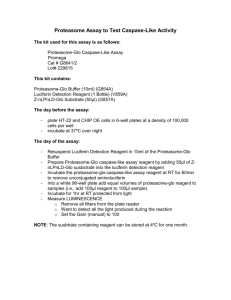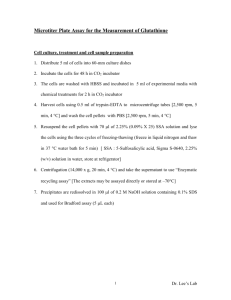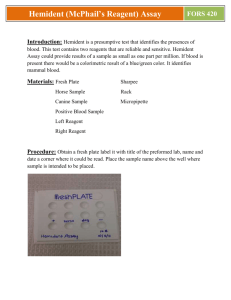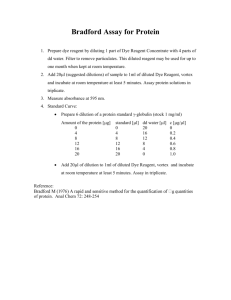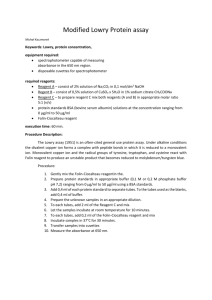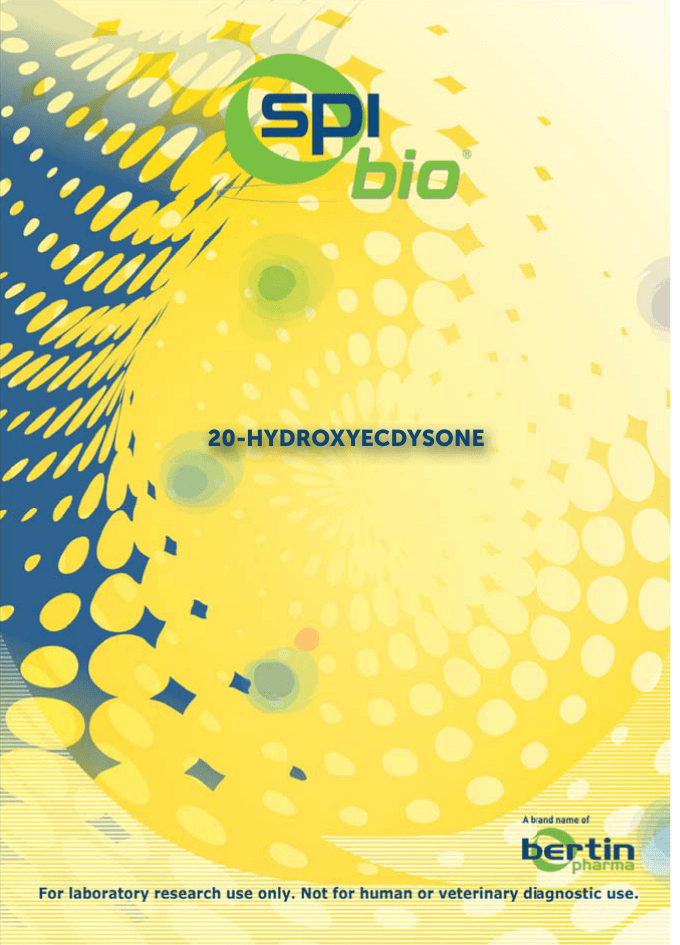
20-HYDROXYECDYSONE
Bertin Pharma also markets preanalytical products, EIA kits, antibodies,
CYP450s & biochemicals for:
Cardiology / Hypertension
Diabetes / Obesity
Endocrinology / Metabolism
Inflammation
Pharmacology
Psychopharmacology
Nitric Oxide
Oncology / Apoptosis
Oxidative injury
Cell signaling
Drug metabolism
Do not hesitate to contact our after-sales services for further
information at bioreagent@bertinpharma.com
European patent # 89 139 552
U.S. patent # 50 47 330
20-Hydroxyecdysone
Enzyme Immunoassay kit
#A05120.96 wells
For research laboratory use only
Not for human diagnostic use
This assay has been developed & validated
by Bertin Pharma
Fabriqué en France
Made in France
#A11120
Version: 0115
A05120 - 20-Hydroxyecdysone
Table of contents
Precaution for use
6
Background
7
Principle of the assay
10
Materials and equipment required
12
Sample collection and preparation
13
Reagent preparation
14
Assay procedure
17
Data analysis
22
Acceptable range
24
Typical results
25
Assay validation and characteristics
26
Troubleshooting
27
Bibliography
28
4
A05120 - 20-Hydroxyecdysone
96 wells
Storage: -20°C
Expiry date: stated on the package
This kit contains:
Designation
Mouse anti-Rabbit precoated
96-well Strip Plate
20-Hydroxyecdysone Tracer
20-Hydroxyecdysone
Antiserum
20-Hydroxyecdysone
Standard
Colour of
cap
blister with
Item #
Quantity
per kit
Form
A08100.1 ea
1
-
green
A04120.100 dtn
1
Lyophilized
red
A03120.100 dtn
1
Lyophilized
A06120.1 ea
2
Lyophilized
A10120.1 ea
2
Lyophilized
Lyophilized
zip
blue with red
septum
20-Hydroxyecdysone
green with
Quality Control
red septum
EIA Buffer
blue
A07000.1 ea
1
Wash Buffer
silver
A17000.1 ea
1
Liquid
Tween® 20
transparent
A12000.1 ea
1
Liquid
A09000_50.100 dtn
2
Lyophilized
Ellman’s reagent_50
black with red
septum
Instruction booklet
-
A11120.1 ea
1
-
Well cover sheet
-
-
1
-
Each kit contains sufficient reagents for 96 wells. This allows
for the construction of one standard curve in duplicate and the
assay of 34 samples in duplicate.
5
A05120 - 20-Hydroxyecdysone
Precaution for use
Users are recommended to carefully read all instructions
for use before starting work.
Each time a new pipette tip is used, aspirate a sample or
reagent and expel it back into the same vessel. Repeat this
operation two or three times before distribution in order to
equilibrate the pipette tip.
>
>
>
>
>
>
For research laboratory use only
Not for human diagnostic use
Do not pipet liquids by mouth
Do not use kit components beyond the expiration date
Do not eat, drink or smoke in the area in which kit
reagents are handled
Avoid splashing
The total amount of reagents contains less than 100 μg of
sodium azide. Flush the drains thoroughly to prevent the
production of explosive metal azides.
Wearing gloves, laboratory coat and glasses is recommended
when assaying kit materials and samples.
Temperature
Unless otherwise specified, all the experiments are done at
room temperature (RT), that is around +20°C. Working at
+25°C or more affects the assay and decreases its efficiency.
6
A05120 - 20-Hydroxyecdysone
Background
Acetylcholinesterase AChE® Technology
Acetylcholinesterase (AChE®), the enzymatic label for EIA, has
the fastest turnover rate of any enzymatic label. This specific
AChE is extracted from the electric organ of the electric
eel, Electrophorus electricus, and it’s capable of massive
catalytic turnover during the generation of the electrochemical
discharges. The use of AChE as enzymatic label for EIA has
been patented by the French academic research Institute
CEA[1, 2, 3], and Bertin Pharma, formerly known as SPIBio, has expertise to develop and produce EIA kits using this
technology.
AChE® assays are revealed with Ellman’s reagent, which
contains acetylthiocholine as a substrate. The final product
of the enzymatic reaction (5-thio-2-nitrobenzoic acid), is bright
yellow and can be read at 405-414 nm. AChE® offers several
advantages compared to enzymes conventionally used in EIAs:
> Kinetic superiority and high sensitivity: AChE®
shows true first-order kinetics with a turnover of 64,000
sec-1. That is nearly 3 times faster than Horse Radish
Peroxidase (HRP) or alkaline phosphatase. AChE® allows
a greater sensitivity than other labeling enzymes.
> Low background: non-enzymatic hydrolysis of
acetylthiocholine in buffer is essentially absent. So,
AChE® allows a very low background and an increased
signal/noise ratio compared to other substrate of
enzymes which is inherently unstable.
7
A05120 - 20-Hydroxyecdysone
>
>
Wide dynamic range: AChE® is a stable enzyme
and its activity remains constant for many hours as,
unlike other enzymes, its substrate is not suicidal. This
permits simultaneous assays of high diluted and very
concentrated samples.
Versatility: AChE® is a completely stable enzyme,
unlike peroxidase which is suicidal. Thus, if a plate
is accidentally dropped after dispatch of the AChE®
substrate (Ellman’s reagent), one only needs to wash the
plate, add fresh Ellman’s reagent and proceed with a
new development. Otherwise, the plate can be stored
at +4°C while waiting for technical advice from the
Bioreagent Department.
20-Hydroxyecdysone
Ecdysone is a steroid hormone of the ecdysteroids family which
is found in animals (vertebrates and invertebrates) and in plants.
There exist different polyhydroxylated forms of ecdysone, the
major one being the 20-Hydroxyecdysone.
20-Hydroxyecdysone (20E) is known as the insect moulting
hormone [20]. Indeed, in interaction with the juvenile
hormone (JH), 20E plays a key role in growth, development,
metamorphosis and reproduction [4, 5] of the Arthropods (i.e.
invertebrates such as insects, crustaceans, arachnids, etc.) [6, 7, 8].
20E regulates target gene transcription by binding a
heterodimeric nuclear receptor composed of the ecdysone
receptor (EcR) and Ultraspiracle (USP) [9, 10, 11].
8
A05120 - 20-Hydroxyecdysone
Various plants synthesize plant-derived ecdysteroids. However,
the role of these phytoecdysteroids (PEs) is not currently wellknown. 20E is widespread in plants and represents the main
PE. These hormones may have a potential role in plant defense
against herbivore pest insects and nematodes [12, 13].
Little is known about the function of ecdysteroids in the
vertebrates. There are several reports which indicate an effect
of the phycoecdysteroid 20E on muscle growth and fat loss
in mammals. Some dietary supplements are marketed to
enhance physical performances of athletes, and particularly
of bodybuilders. Besides, researchers are currently studying
the effect of 20E in the treatment of obesity and diabetes [14,
15]. And there are on-going investigations on the possible
interest of 20E in the prevention and the treatment of diseases
such as osteoporosis and osteoarthritis [16, 17].
Synonyms: 20E, insect molting hormone, 20-OH ecdysone,
β-ecdysone, β-ecdysterone, crustecdysterone, ecdysterone,
20-β-hydroxyecdysterone.
20-Hydroxyecdysone Structure
9
A05120 - 20-Hydroxyecdysone
Principle of the assay
This Enzyme Immunoassay (EIA) is based on the
competition between unlabelled 20-Hydroxyecdysone and
acetylcholinesterase (AChE®)-labelled 20-Hydroxyecdysone
(Tracer) for limited specific rabbit anti-20-hydroxyecdysone
antiserum sites.
The complex rabbit antiserum – 20-Hydroxyecdysone (free 20E
or Tracer) binds to the mouse monoclonal anti-rabbit antibody
coated in the well.
The plate is washed to remove any unbound reagent, and
Ellman’s reagent (enzymatic substrate for AChE and chromogen) is
added to the wells.
The AChE tracer acts on the Ellman’s Reagent to form a yellow
compound that strongly absorbs at 414 nm.
The intensity of the color, determined by spectrophotometry, is
proportional to the amount of tracer bound to the well and is
inversely proportional to the amount of free 20E present in the
well during the immunological incubation.
The kit has been validated by Bertin Pharma in EIA buffer,
and has not been tested on biological samples. However,
several scientists used immunoassay technics to quantify
20-hydroxyecdysone in biological samples like haemolymph
[18, 20, 21, 22].
10
A05120 - 20-Hydroxyecdysone
The principle of the assay is summarised below:
11
A05120 - 20-Hydroxyecdysone
Materials and equipment required
In addition to standard laboratory equipment, the following
material is required:
>
>
>
>
>
>
>
>
>
12
Precision micropipettes (20 to 1000 μL)
Multichannel pipette 100 μL or 200 μL and disposable
tips
Spectrophotometer plate reader (405 or 414 nm filter)
Microplate washer (or washbottles)
Microplate shaker
Magnetic stirring bar
UltraPure water
Polypropylene tubes
Water used to prepare all EIA reagents and buffers
must be UltraPure, deionized & free from organic
contaminants traces.
Otherwise, organic contamination can significantly affect
the enzymatic activity of the tracer AcetylCholinesterase.
Do not use distilled water, HPLC-grade water or sterile
water.
UltraPure water may be purchased from Bertin Pharma
(item #A07001.1L)
A05120 - 20-Hydroxyecdysone
Sample collection and preparation
The kit has been validated in EIA buffer, and has not been
tested on biological samples. However, several scientists used
immunoassay technics to quantify 20-hydroxyecdysone in
biological samples like haemolymph [18, 20, 21, 22].
It is the responsibility of the user to find the proper dilution
according to the type of biological material and to check for
potential interferences (see our website or contact our technical
support).
We suggest the following protocol to prepare biological samples
[18, 19] :
>
Extraction of the 20-Hydroxyecdysone (which is
hydrophobic) with methanol
>
>
>
Centrifugation and collection of the supernatant
Evaporation until completely dry
Dilution in EIA buffer
13
A05120 - 20-Hydroxyecdysone
Reagent preparation
All reagents need to be brought to room temperature, around
+20°C, prior to the assay.
EIA Buffer
Reconstitute the vial #A07000 with 50 mL of UltraPure water.
Allow it to stand 5 minutes until completely dissolved and then
mix thoroughly by gentle inversion.
Stability at 4°C: 1 month
20-hydroxyecdysone Standard
Reconstitute the 20-hydroxyecdysone Standard vial #A06120
with 1 mL of UltraPure water. Allow it to stand 5 minutes
until completely dissolved and then mix thoroughly by gentle
inversion.
The concentration of this first standard S1 is 5000 pg/mL.
Prepare seven propylene tubes for the other standards and
add 500 μL of EIA Buffer into each tube. Then prepare the
standards by serial dilutions as follows:
14
A05120 - 20-Hydroxyecdysone
Standard
Volume of
Volume of Assay
Standard
Buffer
Standard concentration
S1
-
-
5 000 pg/mL
S2
500 μL of S1
500 μL
2 500 pg/mL
S3
500 μL of S2
500 μL
1 250 pg/mL
S4
500 μL of S3
500 μL
625 pg/mL
S5
500 μL of S4
500 μL
312.5 pg/mL
S6
500 μL of S5
500 μL
156.3 pg/mL
S7
500 μL of S6
500 μL
78.1 pg/mL
S8
500 μL of S7
500 μL
39.1 pg/mL
Stability at 4°C: 1 week
20-hydroxyecdysone Quality Control
Reconstitute the vial #A10120 with 1 mL of EIA Buffer. Allow
it to stand 5 minutes until completely dissolved and then mix
thoroughly by gentle inversion.
Stability at +4°C: 1 week
20-hydroxyecdysone Tracer
Reconstitute the vial #A04120 with 5 mL of EIA Buffer. Allow
it to stand 5 minutes until completely dissolved and then mix
thoroughly by gentle inversion.
Stability at +4°C: 1 week
15
A05120 - 20-Hydroxyecdysone
20-hydroxyecdysone Antiserum
Reconstitute the vial #A03120 with 5 mL of EIA Buffer. Allow
it to stand 5 minutes until completely dissolved and then mix
thoroughly by gentle inversion.
Stability at +4°C: 1 week
Wash Buffer
Dilute 2 mL of concentrated Wash Buffer #A17000 with
800 mL of UltraPure water. Add 400 μL of Tween20 #A12000.
Use a magnetic stirring bar to mix the content.
Stability at +4°C: 1 week
Ellman’s Reagent
5 minutes before use (development of the plate), reconstitute
one vial of Ellman’s Reagent #A09000_50 with 50 mL of
UltraPure water. The tube content should be thoroughly mixed.
Stability at 4°C and in the dark: 24 hours
16
A05120 - 20-Hydroxyecdysone
Assay procedure
It is recommended to perform the assay in duplicate and to
follow the instructions hereafter.
Plate preparation
Prepare the Wash Buffer as indicated in the reagent preparation
section.
Open the plate packet and select the sufficient strips for your
assay and place the unused strips back in the packet, store at
+4°C for 1 month maximum.
Rinse each well 4 times with the Wash Buffer 300 μL/well.
Just before distributing reagents and samples, remove the
buffer from the wells by inverting the plate and shaking out the
last drops on a paper towel.
Distribution of reagents and samples
A plate set-up is suggested on the following page.
The content of each well may be recorded on the template
sheet provided at the end of this technical booklet.
Pipetting the reagents
All samples and reagents must reach room temperature prior
to performing the assay.
Use different tips to pipette the buffer, standard, sample,
tracer, antiserum and other reagents.
17
A05120 - 20-Hydroxyecdysone
Before pipetting, equilibrate the pipette tips in each reagent.
Do not touch the liquid already in the well when expeling with
the pipette tip.
>
EIA Buffer
Dispense 100 μL to NSB wells and 50 μL to B0 wells.
> 20-hydroxyecdysone Standards
Dispense 50 μL of each of the eight standards S1 to S8
in duplicate to appropriate wells.
Start with the lowest concentration standard S8 and
equilibrate the tip in the next higher standard before
pipetting.
> Quality Control and samples
Dispense 50 μL in duplicate to appropriate wells. Highly
concentrated samples may be diluted in EIA buffer.
> 20-hydroxyecdysone Tracer
Dispense 50 μL to each well, except Blank (Bk) wells.
> 20-hydroxyecdysone Antiserum
Dispense 50 μL to each well except Blank (Bk) wells
and Non Specific Binding (NSB) wells.
>
18
Incubating the plate
Cover the plate with the cover sheet and incubate
overnight at +4°C.
A05120 - 20-Hydroxyecdysone
Bk: Blank
NSB: Non Specific Binding
QC: Quality Control
B0: Maximum Binding
S1-S8: Standards 1-8
*: Samples
19
A05120 - 20-Hydroxyecdysone
Developing and reading the plate
>
>
>
>
>
>
20
Reconstitute Ellman’s reagent as mentioned in the
Reagent preparation section.
Empty the plate by turning it over. Rinse each well five
times with 300 μL Wash Buffer. At the end of the last
washing step, empty the plate and blot the plate on a
paper towel to discard any trace of liquid.
Add 200μL of Ellman’s reagent to each 96 well. Cover
the plate with an aluminium foil sheet and incubate in
the dark at room temperature. Optimal development is
obtained using an orbital shaker.
Gently wipe the bottom of the plate with a paper towel,
and make sure that no liquid has splashed outside the
wells.
Read the plate at a wavelength between 405 and 414nm
(yellow colour).
After addition of Ellman’s reagent, the absorbance
has to be checked periodically (every 30 minutes)
until the maximum absorbance (B0 wells)
has reached a minimum of 0.200 A.U. blank
subtracted.
A05120 - 20-Hydroxyecdysone
Enzyme Immunoassay Protocole (volumes are in μL)
Blank
NSB
B0
Standard
QC
EIA Buffer
-
100
50
-
-
Sample
-
Standard
-
-
-
50
-
-
QC
-
-
-
-
50
-
Sample
-
-
-
-
-
50
Tracer
-
Antiserum
-
50
-
50
Cover plate, incubate overnight at +4°C
Wash plate 5 times & discard liquid from the wells
Ellman’s reagent
200
Incubate with an orbital shaker at 400 rpm in the dark at RT
Read the plate between 405 and 414 nm
21
A05120 - 20-Hydroxyecdysone
Data analysis
Make sure that your plate reader has subtracted the
absorbance readings of the blank wells (absorbance of Ellman’s
reagent alone) from the absorbance readings of the rest of the
plate. If not, do it now.
22
>
Substract the average absorbance of NSB for each B0,
standards, quality control and samples.
>
Calculate the average absorbance for each B0, standard,
quality control and sample.
>
Calculate the B/B0 (%) for each standard, QC and
sample (average absorbance of standards, QC or sample
divided by average absorbance of B0) & multiplied by 100.
>
Using a semi-log graph paper for each standard point,
plot the B/B0 (%) on y axis versus the concentration
(pg/mL)on x axis. Draw a best-fit line through the points.
>
To determine the concentration of your sample, the
corresponding B/B0 (%) value has to be comprised
between 20% and 80%. Find the B/B0 (%) value on the
y axis. Read the corresponding value on the x axis which
is the concentration of your unknown sample.
>
Diluted samples which concentration determined on
standard curve is greater than 5000 pg/mL should be
re-assayed after appropriated dilution in EIA buffer.
A05120 - 20-Hydroxyecdysone
>
Most plate readers are supplied with curve-fitting
software capable of graphing these data (4-parameter
or 5-parameter logistic fit). If you have this type of
software, we recommend using it. Refer to it for further
information.
Two vials of Quality Control are provided with this
kit.
Your standard curve is validated only if the
calculated concentration of the Quality Control
obtained with the assay is +/- 25% of the
expected concentration (written on the label of
the QC vial)
23
A05120 - 20-Hydroxyecdysone
Acceptable range
>
>
>
>
24
B0 absorbance > 200 mAU blank subtracted in the
conditions indicated above.
NSB absorbance < 35 mAU
IC50: <1000 pg/mL
QC sample: ± 25% of the expected concentration (see
the label of QC vial).
A05120 - 20-Hydroxyecdysone
Typical results
The following data are for demonstration purpose only. Your
data may be different and still correct.
These data were obtained using all reagents as supplied in
this kit under the following conditions: 90 minutes developing
at +20°C, reading at 414 nm. A 4-PL fitting was used to
determine the concentrations.
20-Hydroxyecdysone pg/mL
mAU
B/B0 (%)
Standard S1
5000
120
23.2
Standard S2
2500
160
31.0
Standard S3
1250
211
40.8
Standard S4
625
256
49.5
Standard S5
312.5
310
59.9
Standard S6
156.3
369
71.3
Standard S7
78.1
413
79.7
Standard S8
39.1
451
87.1
B0
0.0
518
100.0
Typical 20-hydroxyecdysone standard curve
25
A05120 - 20-Hydroxyecdysone
Assay validation and characteristics
The Enzyme Immunoassay of 20-Hydroxyecdysone has been
validated in EIA Buffer only.
>
The limit of detection (LOD) of 20-Hydroxyecdysone
corresponding to the B0 average minus three standard
deviations is around 31 pg/mL.
>
The IC50 is the concentration in 20-Hydroxyecdysone
corresponding to 50 % of the maximum Binding is less
than 1000 pg/mL.
>
Cross-reactivity [18]
20-hydroxy-ecdysone
100%
Ecdysone
100%
2-deoxy-20-hydroxy-ecdysone
88%
Polypodine B
70%
2-deoxy-ecdysone
63%
Ponasterone A
43%
Cyasterone
Podecdysone C
Makisterone A
4%
26-hydroxy-ecsydone
1.4%
Muristerone A
1.2%
Kaladasterone
26
5%
4.5%
1%
22-epi-ecdysone
< 0.1%
Posterone
< 0.1%
A05120 - 20-Hydroxyecdysone
Troubleshooting
>
Absorbance values are too low: organic
contamination of water, incubation in wrong conditions
(time or temperature), reading time not long enough,
20-Hydroxyecdysone Tracer has not been dispensed.
>
High signal and background in all wells: inefficient
washing or overdeveloping (incubation time should be
reduced) or high ambiant temperature.
>
High dispersion of duplicates: poor pipetting
technique or irregular plate washing.
These are a few examples of trouble shooting that may occur.
If you need further explanation, Bertin Pharma will be happy
to assist you. Feel free to contact our technical support staff by
phone (+33 (0)139 306 036), fax (+33 (0)139 306 299) or E-mail
(bioreagent@bertinpharma.com), and be sure to indicate the batch
number of the kit (see outside the box).
Bertin Pharma proposes EIA Training kit #B05005.2x96 wells
and EIA workshop upon request. For further information,
please contact our Marketing Dpt by phone (+33 (0)139 306 260)
or E-mail (marketing@bertinpharma.com).
27
A05120 - 20-Hydroxyecdysone
Bibliography
1.
Grassi J, Pradelles P,
Compounds labelled by the acetylcholinesterase of Electrophorus
Electricus. Its preparation process and its use as a tracer or
marquer in enzymo-immunological determinations.
United States patent, N° 1,047,330. September 10, 1991
2.
Grassi J, Pradelles P,
The use of Acetylcholinesterase as a Universal marker in
Enzyme-Immunoassays
Proceedings of the Third International Meeting on
Cholinesterases, American Chemical Society (1991)
3.
Pradelles P, Grassi J, Maclouf J.
Enzyme Immunoassays of Eicosanoids Using
Acetylcholinesterase
Methods in Enzymology (1990), vol. 187, 24-34
Mol Aspects Med. 2003 Aug-Oct;24(4-5):281-91. Review.
4.
A. Abrieux, L. Duportets et al
The GPCR membrane receptor, DopEcR, mediates the actions
of both dopamine and ecdysone to control sex pheromone
perception in an insect.
Frontiers in Behavioral Neuroscience, vol.8, article 312,
September 2014
5.
P. Gabrieli, E. Kakani et al
Sexual transfer of the steroid hormone 20E induces the
postmating switch in Anopheles gambiae.
PNAS, vol.111, No.46, p.16353-16358, November 18, 2014
28
A05120 - 20-Hydroxyecdysone
6.
D. Muramatsu, T. Kinjoh, T. Shinoda and K. Hiruma
The role of 20-hydroxyecdysone and juvenile hormone in pupal
commitment of the epidermis of the silkworm, Bombyx mori.
Mechanisms of development 125, 411-420, 2008
7.
M. Iga and H. Kataoka
Recent studies on insect hormone metabolic pathways mediated
by cytochrome P450 enzymes.
Biological and Pharmaceutical Bulletin, 35(6) 838-843, 2012
8.
P-C. Liu, J-X. Wang, Q-S. Song and X-F. Zhao
The participation of calponin in the cross talk between
20-Hydroxyecdysone and juvenile hormone signaling pathways
by phosphorylation variation.
PLOS One, vol.6, No.5, e19776, May 2011
9.
A. Tan and S. R. Palli
Ecdysone receptor isoforms play distinct roles in controlling
molting and metamorphosis in the red flour beetle, Tribolium
castaneum.
Molecular and Cellular Endocrinology, 291(1-2): 42-49,
September 10, 2008
10. C. Browning, E. Martin et al
Critical role of desolvation in the binding of 20-Hydroxyecdysone
to the Ecdysone receptor.
The Journal of Biological Chemistry, vol.282, No.45, p.3292432934, November 9, 2007
29
A05120 - 20-Hydroxyecdysone
11. R. B. Beckstead, G. Lam and C. Thummel
The genomic response to 20-hydroxyecdysone at the onset of
Drosophila metamorphosis.
Genome Biology, 6:R99, November 2005
12. J-Q. Zhu, S. Liu et al
Improvement of pest resistance in transgenic tobacco plants
expressing dsRNA of an insect-associated gene EcR.
PLOS One, vol.7, No.6, e38572, June 2012
13. K. H. Boo, D. Lee et al
Distribution and biosynthesis of 20-Hydroxyecdysone in plants of
Achyranthes japonica Nakai.
Bioscience, Biotechnology and Biochemistry, 74 (11), 22262231, 2010
14. D. Cheng, L. Kutzler et al
Continuous infusion of 20-Hydroxyecdysone increased mass of
triceps brachii in C57BL/6 mice.
Phytotherapy Research, 27(1): 107-111, January 2013
15. P. Kizelsztein, D. Govorko et al
20-Hydroxyecdysone decreases weight and hyperglycemia in a
diet-induced obesity mice model.
American Journal of Physiology-Endocrinology and Metabolism,
296: E433-E439, 2009
16. L. Gao, G. Cai and X. Shi
β-ecdysone induces osteogenic differentiation in mouse
mesenchymal stem cells and relieves osteoporosis.
Biological and Pharmaceutical Bulletin, 31(12) 2245-2249, 2008
30
A05120 - 20-Hydroxyecdysone
17. S-Y. Sheu, S-R. Ho et al
Arthropod steroid hormone (20-Hydroxyecdysone) suppresses
il-1β-induced catabolic gene expression in cartilage.
BMC Complementary and Alternative Medecine, 15:1, 2015
18. P. Porcheron, M. Morinière, J. Grassi and P. Pradelles
Development of an enzyme immunoassay for ecdysteroids using
acetylcholinesterase as label.
Insect Biochemistry, vol.19, No.2, p.117-122, 1989
19. N. Pascual, X. Bellés et al
Quantification of ecdysteroids by immunoassay : comparison of
enzyme immunoassay and radioimmunoassay.
Zeitschrift für Naturforschung, 50c, 862-867, 1995
20. J. Claret, P. Porcheron and F. Dray
Critical period and ecdydone titers in the pupae of Pieris
brassicae.
Separatum Experientia 33, 1389, 1977
21. P. Porcheron, J. Foucrier, Cl. Gros, P. Pradelles, P. Cassier and F.
Dray
Radioimmunoassay of arthropod moulting hormone:ecdysone
antibodies production and
I-Iodinated tracer preparation.
125
FEBS Letters, vol. 61, No.2, p.159, 1976
22. P. Porcheron, P. Cassier and F. Dray
Applications de techniques immunochimiques à l’étude de
l’ecdysone.
Bull. Soc. Zool. France, Suppl.1, p71-75, 1977
This document is copyrighted. All rights are reserved. This document may not, in whole or part,
be copied, photocopied, reproduced, translated, or reduced to any electronic medium or machine
readable form without the prior consent, in writing, from Bertin Pharma.
31
A05120 - 20-Hydroxyecdysone
32
A05120 - 20-Hydroxyecdysone
33
Bertin Pharma, over the last decades, has been developing and marketing
over 100 biomarker assays, pre-analytical products, kits, antibodies and biochemicals thanks to its innovative work in research and development.
Our core areas are orientated to inflammation, oxidative injury,
endocrinology, diabetes, obesity, hypertension, neurodegenerative diseases,
HIV, prion diseases, pharmacokinetics and metabolism.
Bertin Pharma is active worldwide either with direct sales or through our
qualified and trained international distribution network from the United States
to Japan.
We are able to provide you with local technical support to use at ease our
products.
For further information, please send your request to
bioreagent@bertinpharma.com
care. innovate. deliver.
Parc d’activités du Pas du Lac - 10 bis avenue Ampère
F-78180 Montigny-le-Bretonneux - France
Tel: +33 (0)139 306 036 - Fax: +33 (0)139 306 299
bioreagent@bertinpharma.com - www.bertinpharma.com

